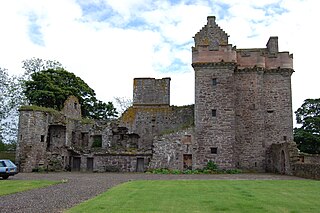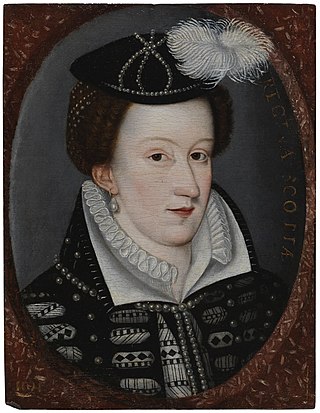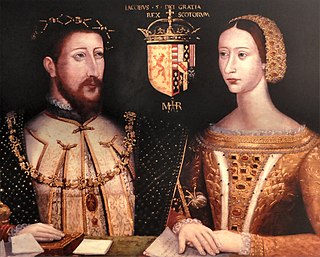Related Research Articles

Mary of Guise, also called Mary of Lorraine, was Queen of Scotland from 1538 until 1542, as the second wife of King James V. She was a French noblewoman of the House of Guise, a cadet branch of the House of Lorraine and one of the most powerful families in France. As the mother of Mary, Queen of Scots, she was a key figure in the political and religious upheaval that marked mid-16th-century Scotland, ruling the kingdom as queen regent on behalf of her daughter from 1554 until her death in 1560.

Madeleine of Valois was a French princess who briefly became Queen of Scotland in 1537 as the first wife of King James V. The marriage was arranged in accordance with the Treaty of Rouen, and they were married at Notre-Dame de Paris in January 1537, despite French reservations over her failing health. Madeleine died in July 1537, only six months after the wedding and less than two months after arriving in Scotland, resulting in her nickname, the "Summer Queen".
Mary Livingston was a Scottish noblewoman and childhood companion of Mary, Queen of Scots, one of the famous "Four Marys".
Alexander Livingston, 5th Lord Livingston of Callendar PC was the guardian of Mary, Queen of Scots, during her childhood.

Mary Beaton, or Bethune as she wrote her family name, was a Scottish courtier. She is remembered in history as one of the four girls who were companions of Mary, Queen of Scots from childhood, known as The Queen's Maries or The Four Maries, and has also entered folklore through the traditional ballad of Marie Hamilton.
Lady Jean Stewart, was an illegitimate daughter of King James V of Scotland by his mistress, Elizabeth Bethune.

The Secret Bond was a document drawn up by Cardinal Beaton and signed at Linlithgow by a number of Scottish peers and lairds on 24 July 1543. They agreed to prevent the marriage of Mary, Queen of Scots, to Prince Edward of England. The document is sometimes called the "Linlithgow Bond". After an agreement was reached with the Governor of Scotland, Regent Arran, Mary moved from Linlithgow Palace to Stirling Castle.
Nichola or Nicolle was a fool or jester to Mary, Queen of Scots.

David Beaton of Melgund was a Scottish courtier and landowner.
Margaret Fleming, Countess of Atholl (1536-1586) was a Scottish courtier and landowner rumoured to be involved in the occult. She served as lady-in-waiting to Mary, Queen of Scots.

Magdalen Livingstone was a Scottish courtier. She was a favoured lady-in-waiting to Mary, Queen of Scots, and later belonged to the household of Prince Henry.
Marie Pieris, Lady Seton was a French lady in waiting at the Scottish court.

The jewels of Mary, Queen of Scots (1542–1587), are mainly known through the evidence of inventories held by the National Records of Scotland. She was bought jewels during her childhood in France, adding to those she inherited. She gave gifts of jewels to her friends and to reward diplomats. When she abdicated and went to England many of the jewels she left behind in Scotland were sold or pledged for loans, first by her enemies and later by her allies. Mary continued to buy new jewels, some from France, and use them to reward her supporters. In Scotland her remaining jewels were worn by her son James VI and his favourites.

John Mosman or Mossman was a Scottish goldsmith based in Edinburgh who served the royal court and was involved in gold mining.
Marie Courcelles was a Scottish court official. She served as lady-in-waiting to Mary, Queen of Scots.

Thomas Arthur was a Scottish tailor who worked for James V of Scotland.

The jewellery and jewels owned by James V of Scotland are mainly known from the royal treasurer's accounts and inventories. James V reinforced his authority by lavish display.
Guyonne de Breüil was a French lady-in-waiting at the court of Mary, Queen of Scots in France and Scotland.
Gillis Mowbray or Gilles Moubray was a servant of Mary, Queen of Scots, associated with a small collection of jewellery held by the National Museums of Scotland, known as the "Penicuik jewels". Her first name is also spelled "Geillis" or "Geilles".
Robert or Robin Fichepain was a French merchant who worked for Francis I of France and Henry II of France, primarily supplying fabrics. Several records of fabrics he supplied to the Scottish court survive.
References
- ↑ Marshall, Rosalind K., "House of Hamilton in its Anglo-Scottish setting in the seventeenth century", University of Edinburgh Research Archive
- ↑ Rosalind K. Marshall: Royal Society of Literature
- ↑ Rosalind K. Marshall, Casemate Academic
- ↑ "Bonnet body tips its hat to McCall Smith", Scotsman, 13 September 2011